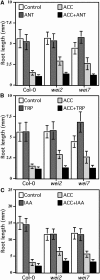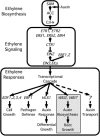A Link between ethylene and auxin uncovered by the characterization of two root-specific ethylene-insensitive mutants in Arabidopsis
- PMID: 15980261
- PMCID: PMC1182485
- DOI: 10.1105/tpc.105.033365
A Link between ethylene and auxin uncovered by the characterization of two root-specific ethylene-insensitive mutants in Arabidopsis
Abstract
The plant hormone ethylene participates in the regulation of a variety of developmental processes and serves as a key mediator of plant responses to biotic and abiotic stress factors. The diversity of ethylene functions is achieved, at least in part, by combinatorial interactions with other hormonal signals. Here, we show that ethylene-triggered inhibition of root growth, one of the classical effects of ethylene in Arabidopsis thaliana seedlings, is mediated by the action of the WEAK ETHYLENE INSENSITIVE2/ANTHRANILATE SYNTHASE alpha1 (WEI2/ASA1) and WEI7/ANTHRANILATE SYNTHASE beta1 (ASB1) genes that encode alpha- and beta-subunits of a rate-limiting enzyme of Trp biosynthesis, anthranilate synthase. Upregulation of WEI2/ASA1 and WEI7/ASB1 by ethylene results in the accumulation of auxin in the tip of primary root, whereas loss-of-function mutations in these genes prevent the ethylene-mediated auxin increase. Furthermore, wei2 and wei7 suppress the high-auxin phenotypes of superroot1 (sur1) and sur2, two auxin-overproducing mutants, suggesting that the roles of WEI2 and WEI7 in the regulation of auxin biosynthesis are not restricted to the ethylene response. Together, these findings reveal that ASA1 and ASB1 are key elements in the regulation of auxin production and an unexpected node of interaction between ethylene responses and auxin biosynthesis in Arabidopsis. This study provides a mechanistic explanation for the root-specific ethylene insensitivity of wei2 and wei7, illustrating how interactions between hormones can be used to achieve response specificity.
Figures








References
-
- Abel, S., Nguyen, M.D., Chow, W., and Theologis, A. (1995). ACS4, a primary indoleacetic acid-responsive gene encoding 1-aminocyclopropane-1-carboxylate synthase in Arabidopsis thaliana: Structural characterization, expression in Escherichia coli, and expression characteristics in response to auxin. J. Biol. Chem. 270 19093–19099; Erratum. J. Biol. Chem. 270, 26020. - PubMed
-
- Alonso, J.M., and Stepanova, A.N. (2004). The ethylene signaling pathway. Science 306 1513–1515. - PubMed
-
- Alonso, J.M., et al. (2003. a). Genome-wide insertional mutagenesis of Arabidopsis thaliana. Science 301 653–657. - PubMed
-
- Arabidopsis Genome Initiative (2000). Analysis of the genome sequence of the flowering plant Arabidopsis thaliana. Nature 408 796–815. - PubMed
Publication types
MeSH terms
Substances
LinkOut - more resources
Full Text Sources
Other Literature Sources
Molecular Biology Databases

